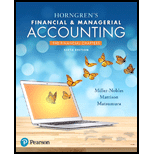
Liabilities: Liabilities are debt and obligations of a business. These are the claims against the resources that a business owes to outsiders of the company. Liabilities may be short-term or long-term depending upon the time duration in which it is paid back to the creditors.
To prepare: Liabilities section of balance sheet.
Trending nowThis is a popular solution!

Chapter 12 Solutions
Horngren's Financial & Managerial Accounting, The Financial Chapters (6th Edition)
- Solace Co. manufactures premium office chairs. During the most productive month of the year, 2,800 chairs were manufactured at a total cost of $98,000. In its slowest month, the company made 800 chairs at a cost of $50,000. Using the high-low method of cost estimation, what is the total fixed costs in October for Solace?arrow_forwardRydell Corp began the accounting period with $48,200 of merchandise, and the net cost of purchases was $289,500. A physical inventory count showed $61,400 of merchandise unsold at the end of the period. The cost of goods sold of Rydell Corp for the period is?arrow_forwardWhat will be the net book value of the equipment?arrow_forward
- What is the estimated amount of inventory on hand?arrow_forwardChalamet Co. sold office furniture costing $15,600 with accumulated depreciation of $12,400 for $2,900 cash. The entry to record the sale would include a gain or loss of what amount?arrow_forwardWhat is the gross profit margin? Given step by step explanation for general accounting questionarrow_forward

 AccountingAccountingISBN:9781337272094Author:WARREN, Carl S., Reeve, James M., Duchac, Jonathan E.Publisher:Cengage Learning,
AccountingAccountingISBN:9781337272094Author:WARREN, Carl S., Reeve, James M., Duchac, Jonathan E.Publisher:Cengage Learning, Accounting Information SystemsAccountingISBN:9781337619202Author:Hall, James A.Publisher:Cengage Learning,
Accounting Information SystemsAccountingISBN:9781337619202Author:Hall, James A.Publisher:Cengage Learning, Horngren's Cost Accounting: A Managerial Emphasis...AccountingISBN:9780134475585Author:Srikant M. Datar, Madhav V. RajanPublisher:PEARSON
Horngren's Cost Accounting: A Managerial Emphasis...AccountingISBN:9780134475585Author:Srikant M. Datar, Madhav V. RajanPublisher:PEARSON Intermediate AccountingAccountingISBN:9781259722660Author:J. David Spiceland, Mark W. Nelson, Wayne M ThomasPublisher:McGraw-Hill Education
Intermediate AccountingAccountingISBN:9781259722660Author:J. David Spiceland, Mark W. Nelson, Wayne M ThomasPublisher:McGraw-Hill Education Financial and Managerial AccountingAccountingISBN:9781259726705Author:John J Wild, Ken W. Shaw, Barbara Chiappetta Fundamental Accounting PrinciplesPublisher:McGraw-Hill Education
Financial and Managerial AccountingAccountingISBN:9781259726705Author:John J Wild, Ken W. Shaw, Barbara Chiappetta Fundamental Accounting PrinciplesPublisher:McGraw-Hill Education





